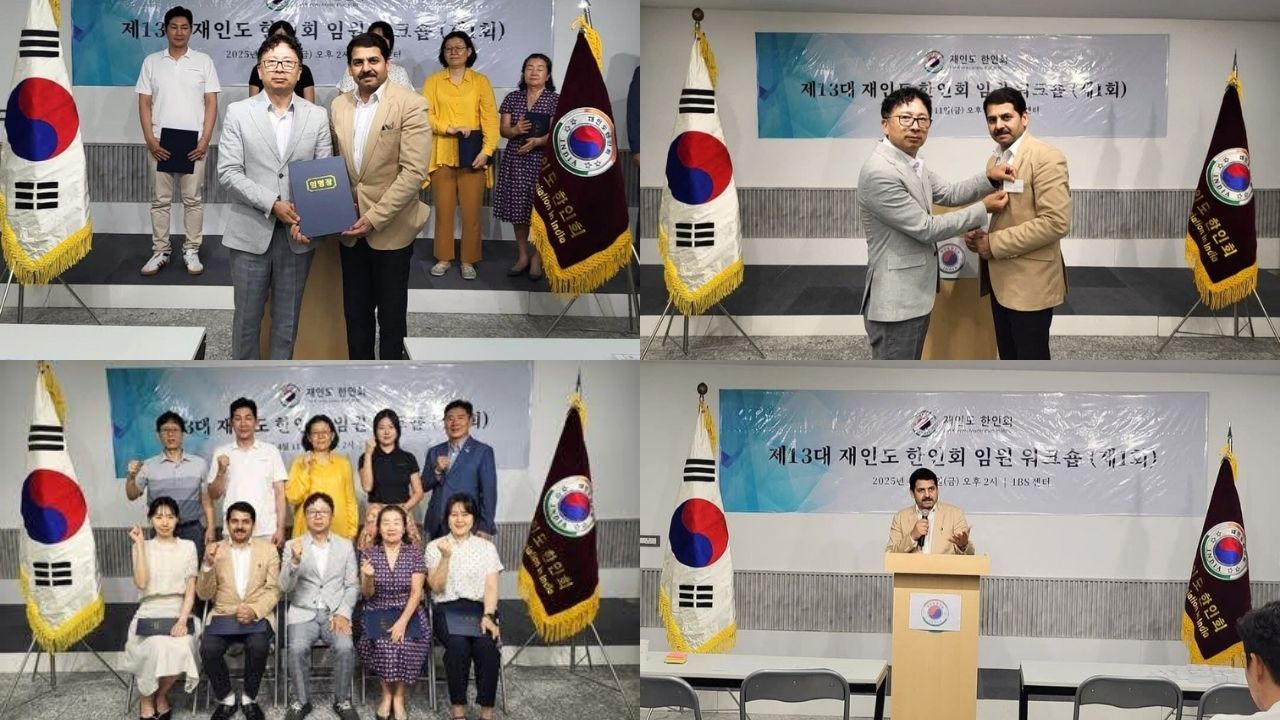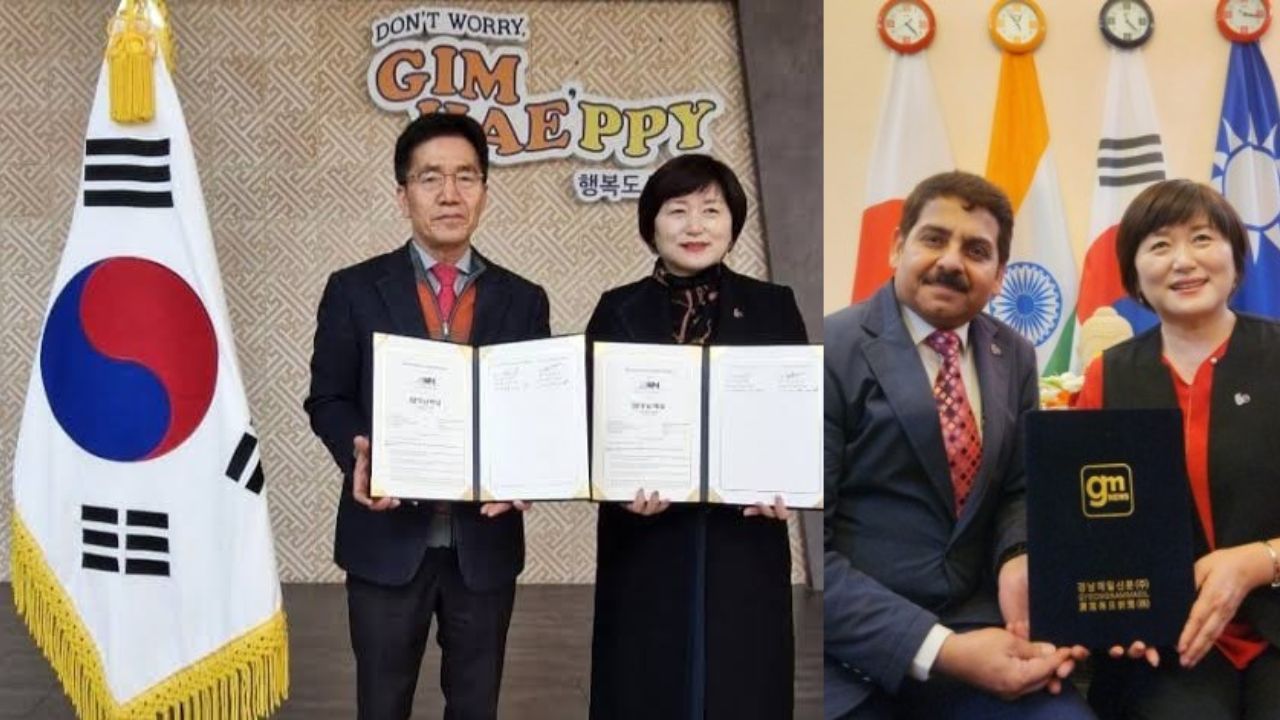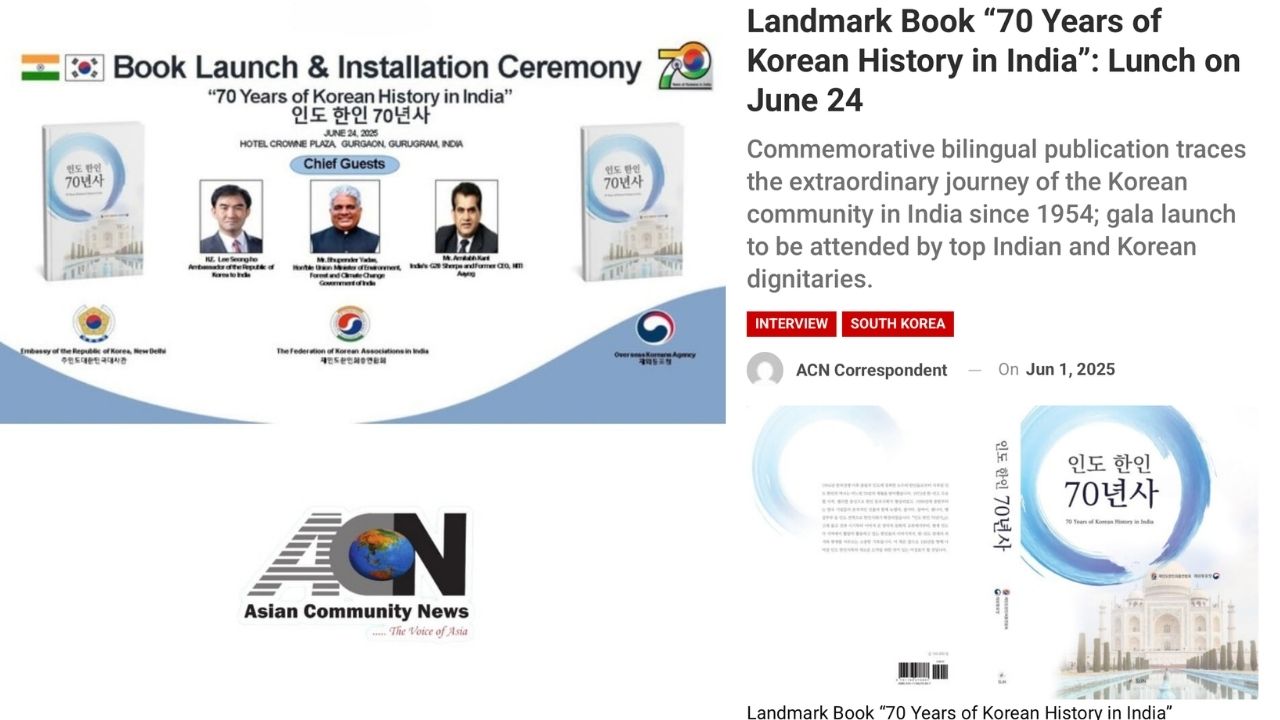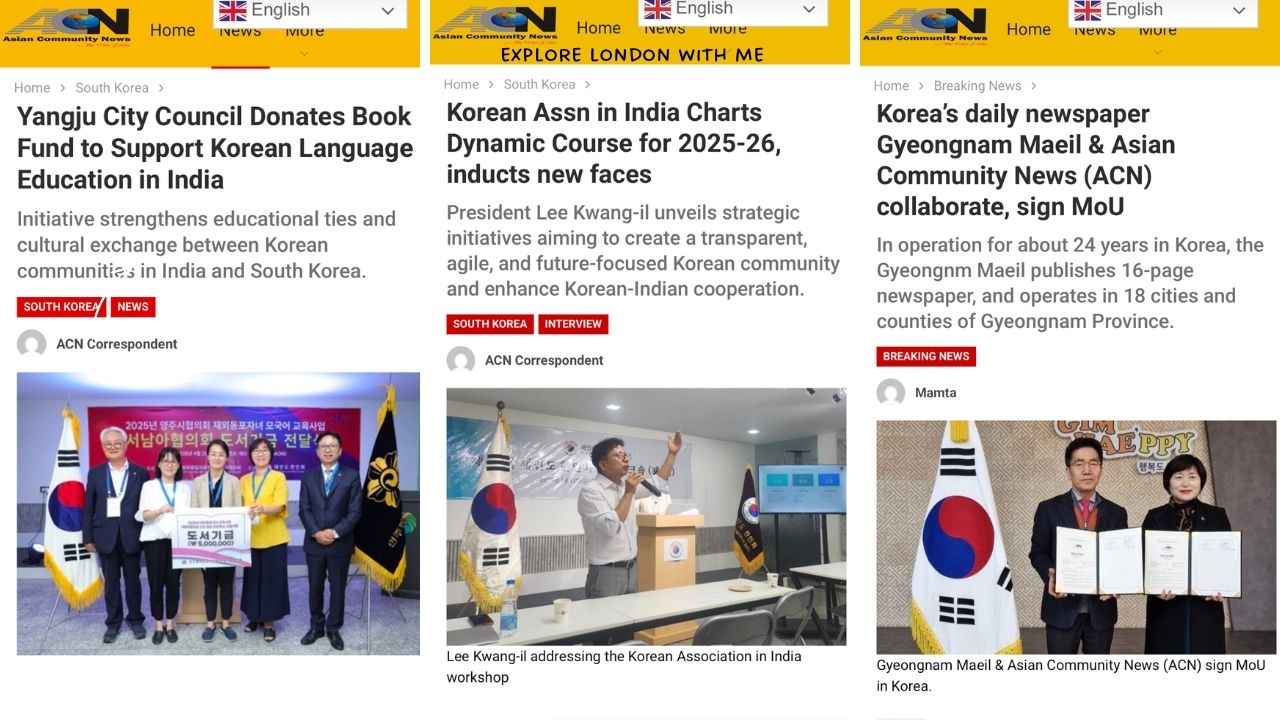[Interview] Bridging India and Korea: An Interview with Sanjeev K. Ahuja on Journalism and Cultural Exchange
2025-08-27The relationship between India and Korea has grown beyond diplomacy and business; it now thrives in everyday exchanges of culture, community, and ideas. From Korean students studying in Indian universities to Indian fans celebrating K-pop and K-dramas, the two nations are finding common ground in meaningful ways. At the center of many of these stories is Mr. Sanjeev K. Ahuja, an Indian journalist with nearly three decades of experience, who has dedicated his career to telling stories that connect people across borders.
Mr. Ahuja, the Founder and Chief Editor (CEO) of Asian Community News (ACN) Network, established the organization in 2019, dedicated to covering India’s engagement with Korea, Japan, and other East Asian nations. His work has highlighted not just political and business developments, but also the softer cultural ties that often go unnoticed in mainstream media. Under his leadership, ACN has become a bridge for readers seeking to understand how Asia’s communities interact, collaborate, and grow together.
Adding to this journey, Mr. Ahuja was recently appointed the Honorary Chairperson of the PR Committee of the Korean Association in India. This new role reflects the trust placed in him by the Korean community and underlines his commitment to strengthening bonds between the two nations. For Mr. Ahuja, journalism is not just about reporting facts, it is about fostering dialogue and ensuring that stories of connection are told with empathy and respect.
Below are excerpts from an email interview with Sanjeev K. Ahuja on Aug 21-25.

1. How do you see Indian youth shaping the cultural bond between India and Korea, not just as consumers of Korean media but also as contributors to this exchange?
Indian youth today are not only enthusiastic consumers of K-content, K-pop, K-dramas, K-food and Korean lifestyle trends, but they are also beginning to reinterpret these influences in uniquely local contexts. From cover dance groups performing in Indian universities to entrepreneurs launching Korean-inspired food and fashion ventures, Indian youth are becoming active contributors rather than passive participants. Across major Indian universities like Delhi University, JNU, and Christ University (Bengaluru), student-led K-pop dance cover groups such as Delhi K-wave and Bangtan INDaNce have become cultural ambassadors. They don’t just mimic choreography they often blend Korean moves with Indian classical or Bollywood expressions. Recent events, such as the All India K-pop Contest 2025 Grand Finale in Delhi, featuring an all-boy NOMAD group, and various K-pop fan meetups, demonstrate the thriving K-wave culture. Several young Indian entrepreneurs are setting up Korean-inspired cafés and eateries. For instance, small cafés in Delhi’s Majnu ka Tilla or Gurgaon’s DLF cyber hubs are run by Indian youth who discovered Korean cuisine through K-dramas and then brought it into local spaces. These aren’t just replicas of Korean menus; many owners give dishes a desi twist like kimchi parathas or spicy Korean fried chicken with Indian masalas creating a fusion that appeals to local tastes while retaining Korean authenticity.
2. How is the Korean community in India enriching local culture, and what lessons can young journalists learn from these everyday interactions?
The Korean community in India whether students, professionals, business leaders, or families offers an invaluable cultural exchange that often happens quietly in neighbourhoods, classrooms, and offices. This vibrant community celebrated its 70th anniversary in India in 2024. And there are numerous living examples of Korean nationals having been working and staying for decades. Mr. Lee Kwang-il, President of the Korean Association in India, moved to India 25 years ago. Many young Koreans have also tied the wedding knots with Indian girls. The Korean community brings with them not only their language, food, and traditions, but also a sense of discipline, community living, and respect for shared spaces that Indians have come to admire. For instance, the visibility of Korean restaurants and cultural festivals in Delhi, Gurugram, Noida, Bengaluru, Pune and other cities is more than about food and entertainment these become gathering points for cross-cultural understanding. What young journalists must realise is that stories of cultural enrichment are often found in the ordinary: a Korean teacher introducing martial arts or the Korean language in a school, or Indian classmates learning Korean phrases from their peers. These everyday narratives carry as much weight as business or political ties, because they show us the human side of international relations. By documenting these lived experiences, journalists can give voice to grassroots diplomacy that binds our societies.

3. In what ways can journalism move beyond headlines to highlight the deeper, positive stories of India–Korea friendship that often remain untold?
Mainstream headlines often centre on high-level summits, movement of ministers and diplomats, trade agreements, or defence partnerships. While these are important, they don’t capture the texture of everyday friendship between India and Korea. Journalism must dive deeper and get hyper-local to uncover stories that reflect people’s lived realities such as the challenges and achievements of Korean students in Indian universities, or the growing number of Indian professionals making careers in Korea’s global companies. Recently, we published a story on the opening of India’s first K-style studio, MEMO4FRAME, in New Delhi, by Korean girl Lee Yukyoung (Kelly), and also on Park Youngmi (Jasmine)’s Delhi GolfZon Academy appointing Indian golfer and Paralympian gold medalist Ranveer Singh Saini, an autistic boy, as its brand ambassador. The mainstream media may not pick up these stories. These stories humanise diplomacy. Positive storytelling is not about softening journalism, but about adding dimensionality to international coverage. For example, highlighting collaborations between Indian and Korean startups, or documenting the rise of Indian K-pop fans who now collaborate with Korean cultural centres, speaks to a more holistic picture of bilateral ties. Journalism must embrace empathy and observation, exploring how these two civilisation ally rich nations are building mutual respect and curiosity. By sharing these stories on ACN platforms – online (www.asiancommunitynews.com) and offline (a monthly, 100-plus-page print news magazine) - we not only inform but also inspire future connections. Recently, we also collaborated with the Korean Association of Bengaluru and Andhra Pradesh (KABA) and signed an MoU to enhance news coverage in the Southern part of India.
4. What opportunities do you see for youth-led media initiatives in strengthening people-to-people connections between the two countries?
Oh yes, immense opportunities exist as India has millions of K-culture enthusiasts craving K-content across its length and breadth. Youth-led media initiatives hold tremendous potential in shaping narratives that traditional or mainstream media may overlook. Today’s young communicators use Instagram reels, YouTube vlogs, podcasts, and fan-driven forums to tell stories that are both authentic and relatable. A Korean youth, Lee Yechan (Charlie), who spent 20 years of his early life in India, has truly become a blue cross-cultural star and celebrity figure among the K-culture-loving youths. He enjoys a huge fan following on social media. Fondly known as Korean Bihari, he runs his YouTube channel @40KAHANI, a digital storytelling platform. If he can do it on foreign soil, Indians can pretty well do it too. For India–Korea ties, such platforms are ideally suited to showcase grassroots cultural exchanges student experiences, food explorations, small business ventures, and artistic collaborations. What makes youth-led media powerful is its interactivity: it engages audiences across borders in real time, turning consumers into collaborators. My advice to young journalists and media enthusiasts is to approach this as a shared storytelling exercise, not a one-way broadcast. With creativity, inclusivity, and digital skills, they can become true cultural ambassadors, offering a fresh lens that complements traditional journalism and diplomacy.
5. Looking ahead, what role can digital storytelling play in creating a shared cultural space for Indians and Koreans over the next decade?
In the next ten years, digital storytelling is poised to become a key player in the cultural exchange between India and Korea. With a staggering 800 million internet users, including 491 million on YouTube, India is home to over 2 million content creators. On average, Indians spend around 6 hours and 49 minutes online each day. These impressive figures clearly show the vast potential for digital storytelling there's really no limit to what can be achieved in this realm. As the boundaries between our physical and virtual worlds continue to blur, stories shared on digital platforms can swiftly connect with audiences. This fosters communities that are linked not by geography but by shared interests. For both Indians and Koreans, this translates to access to authentic narratives. Take, for instance, a Korean entrepreneur in Gurugram sharing their journey on LinkedIn, or an Indian K-pop cover artist reaching millions through YouTube collaborations with Korean creators. Digital storytelling also empowers a variety of voices youth, women, the diaspora, and students to influence how the two nations perceive one another. Many Indian content creators on platforms like YouTube and Instagram are already teaming up with their Korean counterparts. For example, Indian YouTubers who create Korean food reviews or K-drama explainers often collaborate with Koreans living in India to produce bilingual content. Likewise, Korean vloggers in Gurugram or Noida share their experiences of Indian life covering festivals, street food, and work culture captivating large Indian audiences eager to see their homeland through Korean eyes. These collaborations not only humanise cross-cultural experiences but also foster mutual respect by showcasing authentic voices from both sides. Looking forward, I see opportunities for multilingual storytelling platforms, virtual cultural festivals, and joint content creation projects that could create a truly transnational cultural space. Journalists and content creators will need to ensure that these stories remain honest and compassionate. They should avoid stereotypes and celebrate real human connections.

Through his work, Sanjeev K. Ahuja shows us that journalism can be more than news; it can be a living bridge between people and cultures. His journey highlights how the media has the power to capture the pulse of youth, celebrate cultural exchanges, and bring communities closer in meaningful ways. For Indian youth inspired by Korean culture, and for Koreans finding a home in India, such stories create a shared space of dialogue and friendship.

How about this article?
- Like1
- Support0
- Amazing1
- Sad0
- Curious0
- Insightful1


